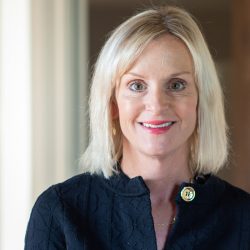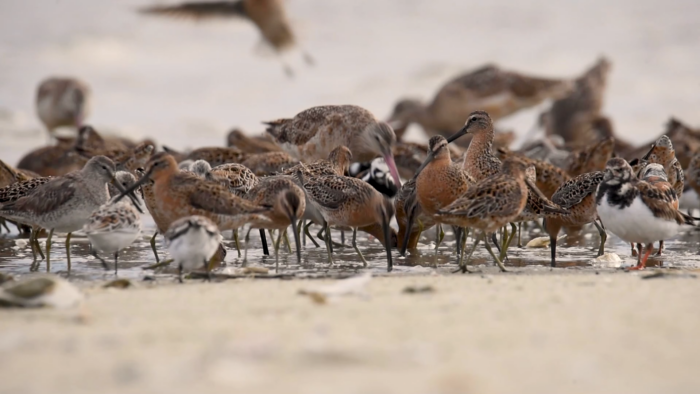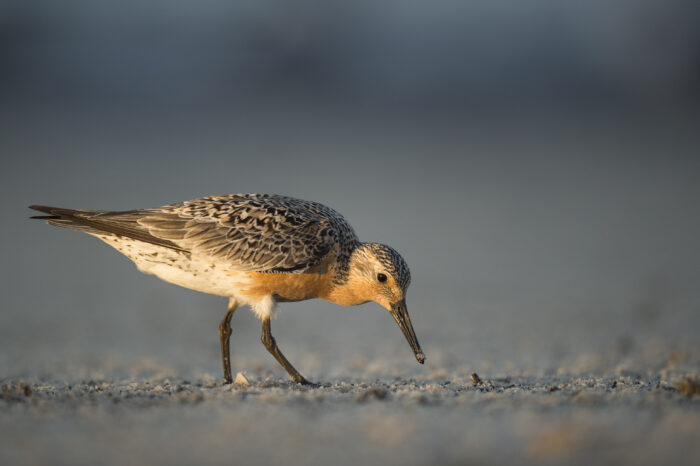A historic victory for horseshoe crabs

Horseshoe crabs and threatened rufa red knots will enjoy enhanced protection in South Carolina following an agreement between Defenders of Wildlife and the Coastal Conservation League, represented by SELC, and Charles River Laboratories and the South Carolina Department of Natural Resources.
Yesterday, a settlement was filed in federal court in the case brought by SELC, Defenders of Wildlife, and the Coastal Conservation League regarding the use of horseshoe crab holding ponds. Today, all parties announced the agreement that, for at least the next five years:
- prohibits horseshoe crab collection on the beaches of over 30 islands across the South Carolina coast that are established feeding sites for red knots during their annual migration;
- continues the prohibition on harvesting anywhere in Cape Romain National Wildlife Refuge;
- prohibits the placement of female horseshoe crabs in holding ponds so they continue to spawn on South Carolina beaches and red knots can access horseshoe crab eggs;
- provides additional permitting conditions that include enhanced protection of horseshoe crabs during the collection process; and,
- provides SCDNR with additional data from contract fishermen.
This landmark settlement comes after years of litigation and represents a huge victory for South Carolina wildlife and the citizens who care about it.
Senior Attorney Catherine Wannamaker
“We are glad that Charles River has agreed to increased protections for red knots and to conduct its operations in South Carolina in a more sustainable way,” says Wannamaker.
The rufa red knot stops on South Carolina’s coast each spring to feed on horseshoe crab eggs along its transpolar journey to the Arctic. Listed under the federal Endangered Species Act, red knots share special relationships with the crabs dubbed “living fossils” that outlived the dinosaurs and resisted evolution, having kept a relatively similar appearance for over 400 million years. Red knots must essentially double their bodyweight by gorging themselves on horseshoe crab eggs to survive their long migration.

At the same time as the birds’ arrival in South Carolina, harvesters for Charles River Laboratories collect spawning horseshoe crabs to use their blood in biomedical testing. The basis of SELC’s federal lawsuit was that these practices denied the red knots access to the eggs they need and threatened their survival. Moreover, this harvest occurs despite the existence of a synthetic alternative to the crab’s blood used by companies like Eli Lilly.
But with the new protections in place, red knots will be ensured access to the food source critical to the transpolar journey and their survival.
This resolution allows for smart, focused restrictions on horseshoe crab harvesting that ensures a critical food source for red knots at vital foraging locations along South Carolina’s coastal plain.
Faith Rivers James, Coastal Conservation League
Second win for horseshoe crabs and red knots this month
This good news follows a decision by the U.S Fish and Wildlife Service, also the result of litigation brought by SELC, that bans horseshoe crab harvesting in Cape Romain National Wildlife Refuge during the crabs’ spawning season.

Earlier this month, the U.S. Fish and Wildlife Service prohibited the commercial harvesting of horseshoe crabs during spawning season when it issued its final compatibility determination stating that the practice is incompatible with the purposes of the refuge and the mission of the National Wildlife Refuge System. This news came in response to a lawsuit brought by SELC on behalf of Defenders of Wildlife that temporarily blocked horseshoe crab harvesting there in 2021, which prompted the Service’s action to address harvesting in the Refuge.
Cape Romain National Wildlife Refuge lies on South Carolina’s coast, made up of 22 miles of barrier islands for visitors and wildlife alike to explore. With its islands and estuaries only accessible by boat, these species enjoy special sanctuary from common habitat disturbances, like development practices, that are common on other parts of the coast.
“Along with the Cape Romain decision, the settlement is an exciting step in our work towards a sustainable future for the people and wildlife of the Southeast,” said Ben Prater, Defenders of Wildlife Southeast Program Director. “This agreement will help maintain the integrity of essential habitats for horseshoe crabs, their spawning grounds and critical food sources for imperiled wildlife including migratory birds like the red knot.”
